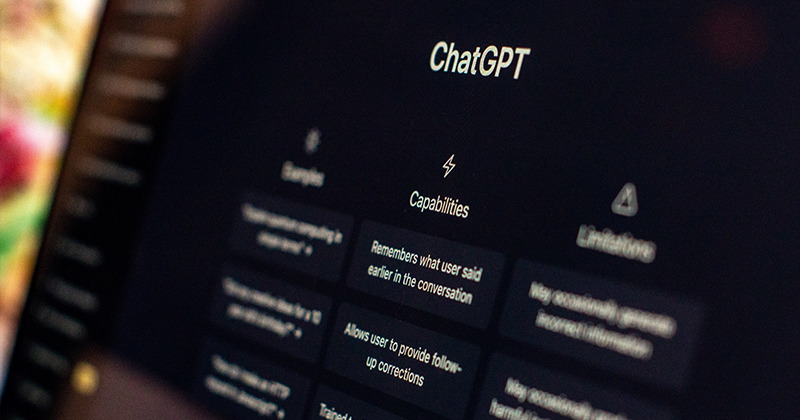
ChatGPT is an advanced deep neural network that operates on the transformer model, capable of generating new text based on input data. Using an ML algorithm called unsupervised learning, the model is pre-trained on vast amounts of text data, allowing it to identify underlying language patterns and structures. Multiple layers of self-attention and feed-forward neural networks comprise the model, enabling it to capture the intricate relationships and dependencies between words within a sentence.
Language modeling is the primary task during pre-training, where the model predicts the next word in a given text sequence based on previous words. As a result, the model acquires a high-quality representation of the language. After pre-training, the model can fine-tune specific natural language processing tasks such as sentiment analysis, language translation, and text classification.
One of the most significant benefits of ChatGPT is its ability to generate coherent, contextually appropriate responses to text inputs, even for open-ended prompts like chatbot conversations. The pre-trained model generates a probability distribution over the next word in the sequence, and the output is sampled from this distribution.
The exciting role of ChatGPT in data science
Data science is an exciting and ever-evolving field that requires constant learning and adaptation to stay ahead. Fortunately, ChatGPT, an AI language model, can play a vital role in this process by providing data science professionals with a range of benefits that makes it an indispensable resource for acquiring new skills and staying up-to-date with industry trends.
Here are some ways in which ChatGPT can help you enhance your knowledge of data-driven decision-making:
- Personalized Learning Assistance: ChatGPT can provide personalized assistance by understanding the context of a user's query and delivering tailored explanations, examples, and resources to help learners comprehend complex data science concepts better.
- Access to Diverse Learning Resources: The extensive knowledge base of the tool enables it to recommend a wide range of learning resources for data science, including articles, tutorials, online courses, books, and videos from reputable sources.
- Networking and Collaboration: The language model can assist in networking and collaboration within the data science community, generating conversation starters or discussion topics to engage with peers, mentors, and industry experts, fostering a collaborative learning environment, and expanding their professional network.
- Practice Problem Generation: ChatGPT can generate practice problems and coding challenges related to various data science topics, allowing learners to test their knowledge and develop problem-solving skills.
- Interactive Learning Environment: The AI assistant provides an interactive learning environment that enables users to ask questions, receive immediate feedback, and engage in conversations about data science topics, fostering a deeper understanding and helping to solidify knowledge.
- Code Explanation and Debugging Assistance: ChatGPT can help learners by providing explanations for specific code snippets, offering suggestions for improvements, and even assisting with debugging issues.
- Staying Current with Industry Trends: ChatGPT is an intelligent agent that can provide information on recent developments, emerging technologies, and new methodologies, ensuring that users are aware of the latest trends and best practices in the industry.
Significant examples of ChatGPT in action
ChatGPT is a versatile tool that has been used across various industries, including healthcare, finance, and marketing. Here are some examples of its applications:
- Healthcare: Although human doctors will always remain the ultimate decision-makers in healthcare, ChatGPT can greatly assist with clinical decision support. By providing real-time, evidence-based recommendations, the AI language model can help flag potential drug interactions, suggest treatment options for specific conditions, and provide relevant clinical guidelines.
- Marketing: ChatGPT can revolutionize marketing by engaging in personalized conversations with potential customers, answering their queries, and providing information about products and services. It can also be integrated into lead generation forms, offering recommendations and assistance.
- Finance: ChatGPT has been utilized to predict financial market trends and identify potential investment opportunities. It has also been utilized to develop intelligent agents that can assist customers with basic financial queries.
ChatGPT prompts for data science professionals
ChatGPT prompts are initial messages or inputs given to the language model to start generating responses or outputs. These prompts are typically a few words or sentences that provide context and direction to the model about the type of response that is expected. The prompts can be in the form of questions, statements, or incomplete phrases.
They can guide the model to produce accurate and relevant responses, streamline the process, generate bulk responses, and tailor them to the user's needs. In short, ChatGPT prompts are a valuable tool for generating high-quality responses quickly and efficiently.
-
Prompt 1: Provide me a Python Code Snippet for a decision tree classifier.
ChatGPTfrom sklearn.datasets import load_iris
from sklearn.tree import DecisionTreeClassifier
from sklearn.model_selection import train_test_split
from sklearn.metrics import accuracy_score# load the iris dataset
iris = load_iris()
X = iris.data
y = iris.target# split the dataset into training and testing sets
X_train, X_test, y_train, y_test = train_test_split(X, y, test_size=0.3, random_state=42)# create a decision tree classifier
clf = DecisionTreeClassifier()# fit the classifier to the training data
clf.fit(X_train, y_train)# make predictions on the testing data
y_pred = clf.predict(X_test)# calculate the accuracy of the classifier
accuracy = accuracy_score(y_test, y_pred)print("Accuracy: {:.2f}%".format(accuracy * 100))
In this example, we are using the Iris dataset, which consists of samples of iris flowers and their corresponding species. We first split the data into training and testing sets, and then create a decision tree classifier using the DecisionTreeClassifier() function from the sklearn.tree module. We fit the classifier to the training data using the fit() method and then make predictions on the testing data using the predict() method. Finally, we calculate the accuracy of the classifier using the accuracy_score() function from sklearn.metrics module, and print the result to the console.
-
Prompt 2: Give an example of a data science project where teamwork was essential to the project's success.
ChatGPTOne example of a data science project where teamwork was essential to its success is the development of a recommendation system for an e-commerce website.
In this project, data scientists would need to work closely with developers and product managers to gather requirements, understand the business goals and limitations, and identify the data sources needed to build the recommendation system.
The data scientists would then need to collaborate with data engineers to collect, clean, and pre-process the data before feeding it into the recommendation algorithm.
Once the algorithm is developed, the data scientists would need to work with developers to integrate the algorithm into the website and test it rigorously to ensure that it works as intended.
Finally, the project team would need to analyze the performance of the recommendation system and make iterative improvements based on user feedback and data analytics.
Throughout the entire project, effective communication and collaboration between team members would be critical to ensuring the success of the project.
-
Prompt 3: I want you to act as a programmer and write a simple code to detect customer response rate.
ChatGPTTo detect the customer response rate, we first need to define what we consider as a response. Let's assume that a response is when a customer completes a specific action, such as filling out a survey or making a purchase.
Assuming that you have a dataset with customer information, including whether or not they responded, and the total number of customers who were contacted, here's a simple Python code to calculate the response rate:
import pandas as pd
# Load the dataset into a Pandas dataframe
df = pd.read_csv('customer_data.csv')# Calculate the total number of customers contacted
total_customers_contacted = len(df)# Calculate the total number of customers who responded
total_customers_responded = len(df[df['responded'] == 1])# Calculate the response rate
response_rate = (total_customers_responded / total_customers_contacted) * 100# Print the response rate
print('Response rate: {:.2f}%'.format(response_rate))This code loads the customer data into a Pandas dataframe, calculates the total number of customers contacted and the total number of customers who responded, and then calculates the response rate as a percentage. Finally, it prints the response rate to the console.
Note that this is a very simple example, and in real-world scenarios, there may be more complex factors that affect the response rate, such as demographics, time of day, and marketing channel used.
As a data science professional, you can learn, collaborate, and stay updated with the latest trends in the field. The aforementioned prompts are examples of how ChatGPT can provide in-depth information for professionals at all levels aiding you to enhance your data science skills and expertise.
Some other examples of prompts you could use are:
-
R to Python translation
Prompt: Think of yourself as a code translator, please. The following R code needs to be converted to Python. [Put code here]
- Microsoft Excel formula
Prompt: Please assume the role of an Excel sheet specialist who can create formulas for Excel sheets. Please provide a formula that meets the following criteria.
- Python-based production of synthetic data
Prompt: Assume you are a Python programmer. Can you create a piece of code that produces fake data for a client database?
Tips for generating data science prompts
- Offer context: When asking ChatGPT a question, provide context that helps the model understand the nuances of the problem. This allows it to generate more informed responses.
- Be precise: To minimize the need for tweaking output, be clear about the input and desired outcome when posing a question to ChatGPT.
- Keep trying: Don't be afraid to try multiple prompts. Using different prompts can provide different perspectives on a problem and enable the model to generate a variety of responses.
Final Takeaways…
According to Sam Altman, the creator of ChatGPT, the future of AI is both awe-inspiring and alarming, and its potential is virtually boundless. Currently, GPT-4 is in development and is expected to be the most advanced large language model at launch.
ChatGPT can address the lack of specialists in the data science field by training laypeople to code and program solutions to analytics problems. This could make data science more accessible and attractive to individuals who previously found it daunting. To remain competitive, data scientists should focus on how they can augment their skills using this intelligent agent. ChatGPT's impact on society becomes evident, and other tech giants such as Google are developing their own models. It will be intriguing to observe their performance in comparison to Al chatbot, and how they will contend with its dominance in the field in the foreseeable future.
































